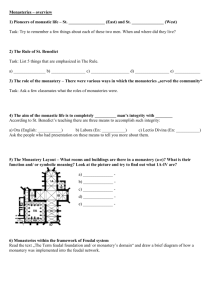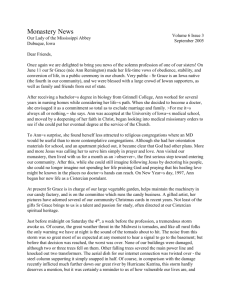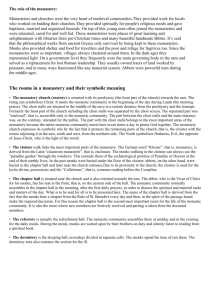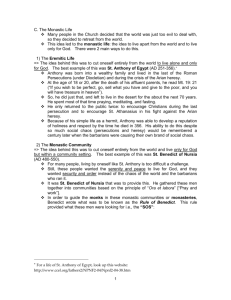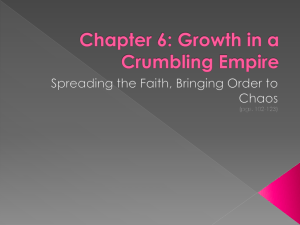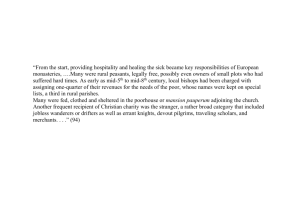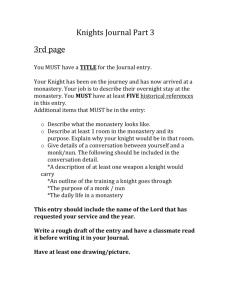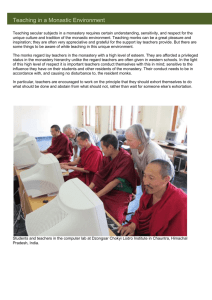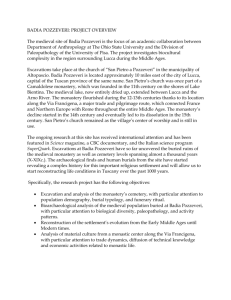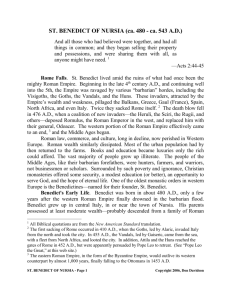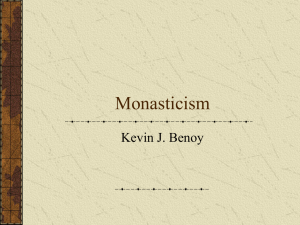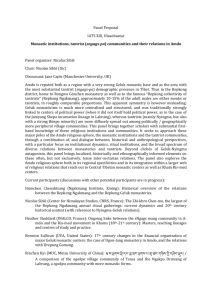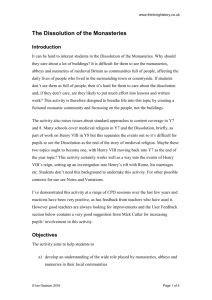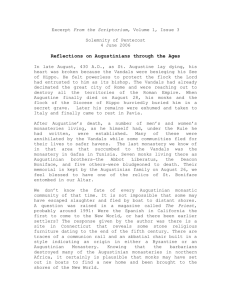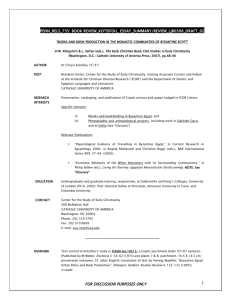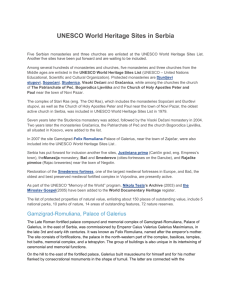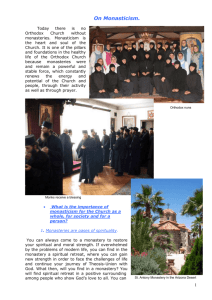Section 1
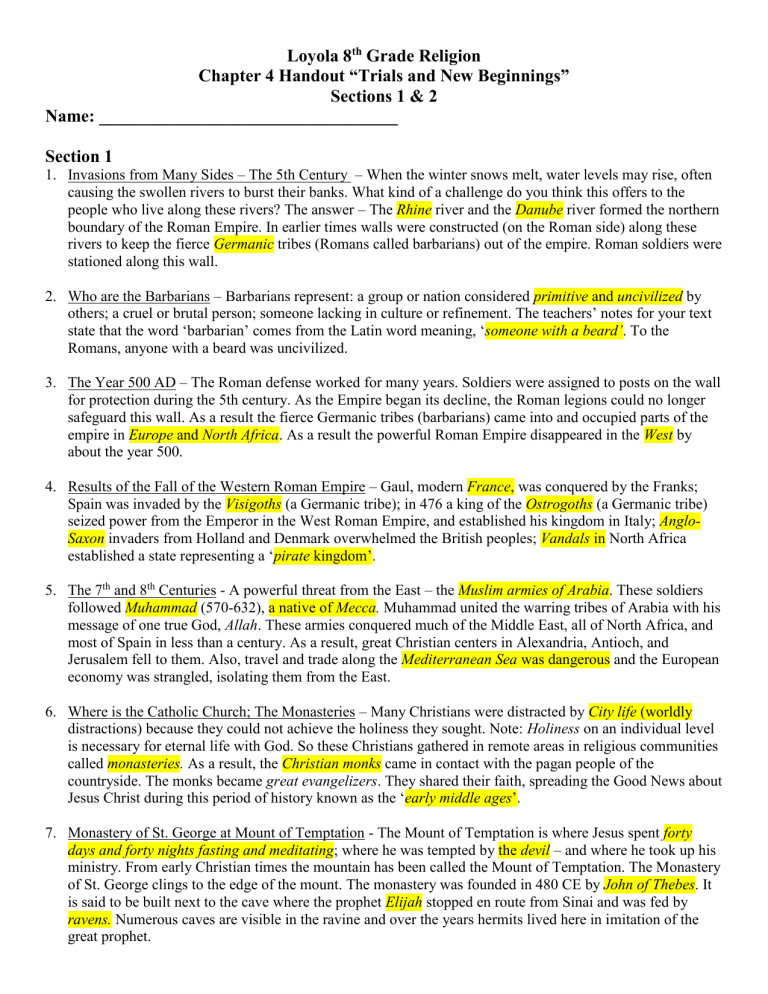
Loyola 8
th
Grade Religion
Chapter 4 Handout “Trials and New Beginnings”
Sections 1 & 2
Name: __________________________________
Section 1
1.
Invasions from Many Sides – The 5th Century – When the winter snows melt, water levels may rise, often causing the swollen rivers to burst their banks. What kind of a challenge do you think this offers to the people who live along these rivers? The answer – The Rhine river and the Danube river formed the northern boundary of the Roman Empire. In earlier times walls were constructed (on the Roman side) along these rivers to keep the fierce Germanic tribes (Romans called barbarians) out of the empire. Roman soldiers were stationed along this wall.
2.
Who are the Barbarians – Barbarians represent: a group or nation considered primitive and uncivilized by others; a cruel or brutal person; someone lacking in culture or refinement. The teachers’ notes for your text state that the word ‘barbarian’ comes from the Latin word meaning, ‘ someone with a beard’
. To the
Romans, anyone with a beard was uncivilized.
3.
The Year 500 AD – The Roman defense worked for many years. Soldiers were assigned to posts on the wall for protection during the 5th century. As the Empire began its decline, the Roman legions could no longer safeguard this wall. As a result the fierce Germanic tribes (barbarians) came into and occupied parts of the empire in Europe and North Africa . As a result the powerful Roman Empire disappeared in the West by about the year 500.
4.
Results of the Fall of the Western Roman Empire – Gaul, modern France , was conquered by the Franks;
Spain was invaded by the Visigoths (a Germanic tribe); in 476 a king of the Ostrogoths (a Germanic tribe) seized power from the Emperor in the West Roman Empire, and established his kingdom in Italy; Anglo-
Saxon invaders from Holland and Denmark overwhelmed the British peoples; Vandals in North Africa established a state representing a ‘ pirate kingdom’.
5.
The 7 th
and 8 th
Centuries - A powerful threat from the East – the Muslim armies of Arabia . These soldiers followed Muhammad (570-632), a native of Mecca.
Muhammad united the warring tribes of Arabia with his message of one true God, Allah . These armies conquered much of the Middle East, all of North Africa, and most of Spain in less than a century. As a result, great Christian centers in Alexandria, Antioch, and
Jerusalem fell to them. Also, travel and trade along the Mediterranean Sea was dangerous and the European economy was strangled, isolating them from the East.
6.
Where is the Catholic Church; The Monasteries – Many Christians were distracted by City life (worldly distractions) because they could not achieve the holiness they sought. Note: Holiness on an individual level is necessary for eternal life with God. So these Christians gathered in remote areas in religious communities called monasteries.
As a result, the Christian monks came in contact with the pagan people of the countryside. The monks became great evangelizers . They shared their faith, spreading the Good News about
Jesus Christ during this period of history known as the ‘ early middle ages
’.
7.
Monastery of St. George at Mount of Temptation - The Mount of Temptation is where Jesus spent forty days and forty nights fasting and meditating ; where he was tempted by the devil – and where he took up his ministry. From early Christian times the mountain has been called the Mount of Temptation. The Monastery of St. George clings to the edge of the mount. The monastery was founded in 480 CE by John of Thebes . It is said to be built next to the cave where the prophet Elijah stopped en route from Sinai and was fed by ravens.
Numerous caves are visible in the ravine and over the years hermits lived here in imitation of the great prophet.
Section 2
8.
The Monastic Movement - There have been men and women who wanted to dedicate their lives to worshiping God by living the Christian life more fully. This lifestyle became known as the monastic movement . It lives today. As a favored religion in the 4th Century, various people came into the Christian fold. Some, however, came for the wrong reason. They came only to obtain power & influence . The monastic movement was the ‘grass roots’ response to this infidelity. It was formed by devout laypeople around the time of Constantine.
9.
Antony (251-356) an Egyptian Christian - Around 271 Antony went to the Egyptian desert to live a solitary life of prayer & deep thought. Others followed. What were these people called? Hermits – people who live alone, separated from the rest of the society . They lived alone or in small groups. What does the word monastic or monastery mean? It means living alone, away from the world .
10.
Saint Benedict (480-550) Abbot( Spiritual Father) of Monte Cassino (small Italian Monastery) - The monastic life became popular and spread throughout western Europe, producing many famous people. The most famous – St. Benedict. His motto was ‘work and prayer’, which included manual labor in the fields and community prayer at fixed times, day & night. He lived and died as the abbot of Monte Cassino, which he found in 529. Saint Benedict was known for his “Rule”. This was Benedict’s ‘rule’ or ‘guide to the monastic life’. The daily routine was manual labor & prayer. It became popular and spread throughout the world.
11.
The effect of Benedict’s Rule – In Europe it brought unity under the cross of Christ. The greatest weakness of Benedictine monasticism was that each monastery was totally independent using their own rules. The monks in a monastery were accountable to NO ONE outside the monastery.
12.
Monastery at Cluny, France 910 AD – In this Monastery, the Monks emphasized prayer and downplayed physical labor. Hundreds of monasteries affiliated themselves with Cluny and the abbot of Cluny became very powerful. They became large and wealthy; prayers became elaborate, taking 8 hours to finish. This was not Benedict’s vision (small devout communities). As a result many strayed from the Benedictine philosophy.
13.
Dissatisfaction with Cluny – Monks cried for a ‘return to the spirit of the desert’; leading to a new religious order, stricter than Benedict’s. The Cistercian monasteries followed a very strict rule of prayer, manual labor, little sleep and meager food. The Cistercian monasteries were located in remote areas, away from distractions of everyday life. Despite hardships, recruits came by the 1,000s, attracted by the leadership of
Saint Bernard. He found the Cistercian monastery at Clairvaux.
14.
The Outcome of the Monastic Movement – Many Religious Orders arose in the Middle Ages. These orders reformed themselves revealing spiritual strength and creativity of the Christian monastic movement. Note: It is very much alive in the Church today. There are Monasteries throughout the world.
